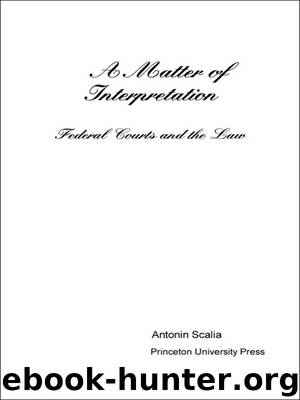A Matter of Interpretation by Antonin Scalia

Author:Antonin Scalia [Scalia, Antonin]
Language: eng
Format: epub
ISBN: 978-1-4008-2217-1
Publisher: Princeton University Press
Published: 1997-04-20T04:00:00+00:00
1 See Scalia, “Common-Law Courts in a Civil-Law System,” p. 46.
2 Id., p. 38.
3 Id. See also id., p. 47 (criticizing this view as making the Constitution a “‘morphing’ document”).
4 See Ronald Dworkin, Law’s Empire(1987).
5 See Robert H. Bork, The Tempting of America75–76, 82 (1990) (defending the result in Brown v. Board of Education, notwithstanding his view that those who ratified the Fourteenth Amendment did not think it outlawed segregation).
6 U.S. Const. art. I, 9, cl. 3; art. I, 10, cl. 1.
7 See John H. Ely, Note, The Bounds of Legislative Specification: A Suggested Approach to the Bill of Attainder Clause, 72 Yale L.J. 330 (1962) (urging the broader reading).
8 See Laurence H. Tribe, American Constitutional Law10-1 to 10-6 (2d ed. 1988). Compare Justice Scalia’s reading of the words “speech and press” as a “synecdoche for the whole” of “communication,” “Common-Law Courts in a Civil-Law System,” p. 38, including modes known in 1791, id.(“[h]and-written letters”) and modes then unimaginable, id., p. 45 (e.g., “over-the-air television”).
9 When such deliberate compromises appear to underlie a constitutional gap or seeming inconsistency—as, for example, with the absence of any ban on federal as opposed to state laws impairing the obligation of contracts—then fidelity to the entirety of the text and structure of course compels us to construe the document in a manner that honors those compromises rather than seeks to “correct” the perceived “flaws.”
10 See Sanford Levinson, The Embarrassing Second Amendment, 99 Yale L.J. 637 (1989). Interestingly, Justice Scalia does appear willing to treat the Second Amendment, despite the reference in its preamble to state militias, as embodying some principle about what he refers to as “the right of self-defense.” “Common-Law Courts in a Civil-Law System,” p. 43.
11 The right not to have the government put its regiments in one’s home might make little sense without some presupposed right not to have the government regiment every detail of what one does in one’s home. See Griswold v. Connecticut, 381 U.S. 479, 484 (1965) (observing that the Third Amendment is “another facet” of privacy).
12 See, e.g., Akhil Reed Amar, Fourth Amendment First Principles, 107 Harv. L. Rev. 757, 785 (1994) (discussing the Fourth Amendment’s substantive protection of “the right of the people to be secure in their persons, houses, papers, and effects”).
13 See notes 28–29 and accompanying text, infra.
14 Professor Dworkin’s reply to Justice Scalia suggests that he would focus on what various officials understood by the words they wrote or voted to ratify, while Justice Scalia would apparently focus on what a reasonably well-informed citizen of the time would have understood. In his earlier writing, Professor Dworkin elaborated a more nuanced (and, I believe, more defensible) answer than either of these. See, e.g., Dworkin, supra note 4, at 317–38, 361–69.
15 Scalia, “Common-Law Courts in a Civil-Law System,” p. 38. But see notes 53–57 and accompanying text, infra.
16 I refer here to Professor Dworkin’s reply to Justice Scalia; his extraordinary book Law’s Empire, supra note 4, stakes out a far more subtle position, which I make no attempt to address in this essay.
Download
This site does not store any files on its server. We only index and link to content provided by other sites. Please contact the content providers to delete copyright contents if any and email us, we'll remove relevant links or contents immediately.
Day by Elie Wiesel(2241)
The Age of Genius by A. C. Grayling(2173)
Gideon's Spies: The Secret History of the Mossad by Gordon Thomas(1950)
The Gulag Archipelago (Vintage Classics) by Aleksandr Solzhenitsyn(1725)
FATWA: Hunted in America by Pamela Geller(1720)
Columbine by Dave Cullen(1495)
Examples & Explanations: Administrative Law by William F. Funk & Richard H. Seamon(1325)
The Rule of Law by Bingham Tom(1318)
Men Explain Things to Me by Rebecca Solnit(1312)
Anatomy of Injustice by Raymond Bonner(1268)
Three Cups of Tea by Greg Mortenson(1256)
ADHD on Trial by Michael Gordon(1237)
That Every Man Be Armed by Stephen P. Halbrook(1236)
Gideon's Spies by Gordon Thomas(1213)
Palestinian Walks by Raja Shehadeh(1141)
The Source by James A. Michener(1133)
Fast Times in Palestine by Pamela Olson(1115)
Nothing to Envy by Barbara Demick(1040)
Constitutional Theory by Carl Schmitt(1034)
